2004 FORD F SERIES MOTORHOME AND COMMERCIAL CHASSIS adding oil
[x] Cancel search: adding oilPage 10 of 120
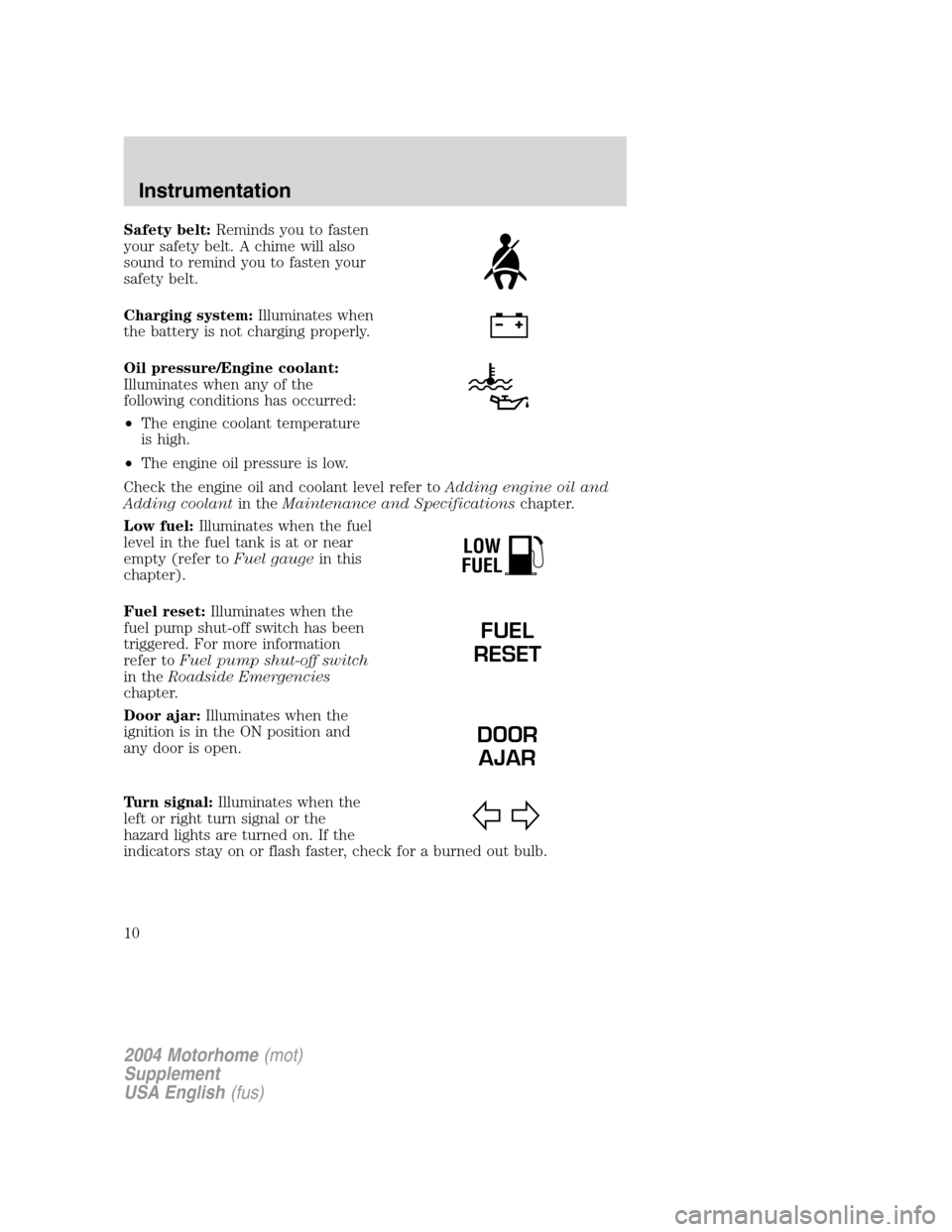
Safety belt:Reminds you to fasten
your safety belt. A chime will also
sound to remind you to fasten your
safety belt.
Charging system:Illuminates when
the battery is not charging properly.
Oil pressure/Engine coolant:
Illuminates when any of the
following conditions has occurred:
•The engine coolant temperature
is high.
•The engine oil pressure is low.
Check the engine oil and coolant level refer toAdding engine oil and
Adding coolantin theMaintenance and Specificationschapter.
Low fuel:Illuminates when the fuel
level in the fuel tank is at or near
empty (refer toFuel gaugein this
chapter).
Fuel reset:Illuminates when the
fuel pump shut-off switch has been
triggered. For more information
refer toFuel pump shut-off switch
in theRoadside Emergencies
chapter.
Door ajar:Illuminates when the
ignition is in the ON position and
any door is open.
Turn signal:Illuminates when the
left or right turn signal or the
hazard lights are turned on. If the
indicators stay on or flash faster, check for a burned out bulb.
LOW
FUEL
FUEL
RESET
DOOR
AJAR
2004 Motorhome(mot)
Supplement
USA English(fus)
Instrumentation
10
Page 69 of 120
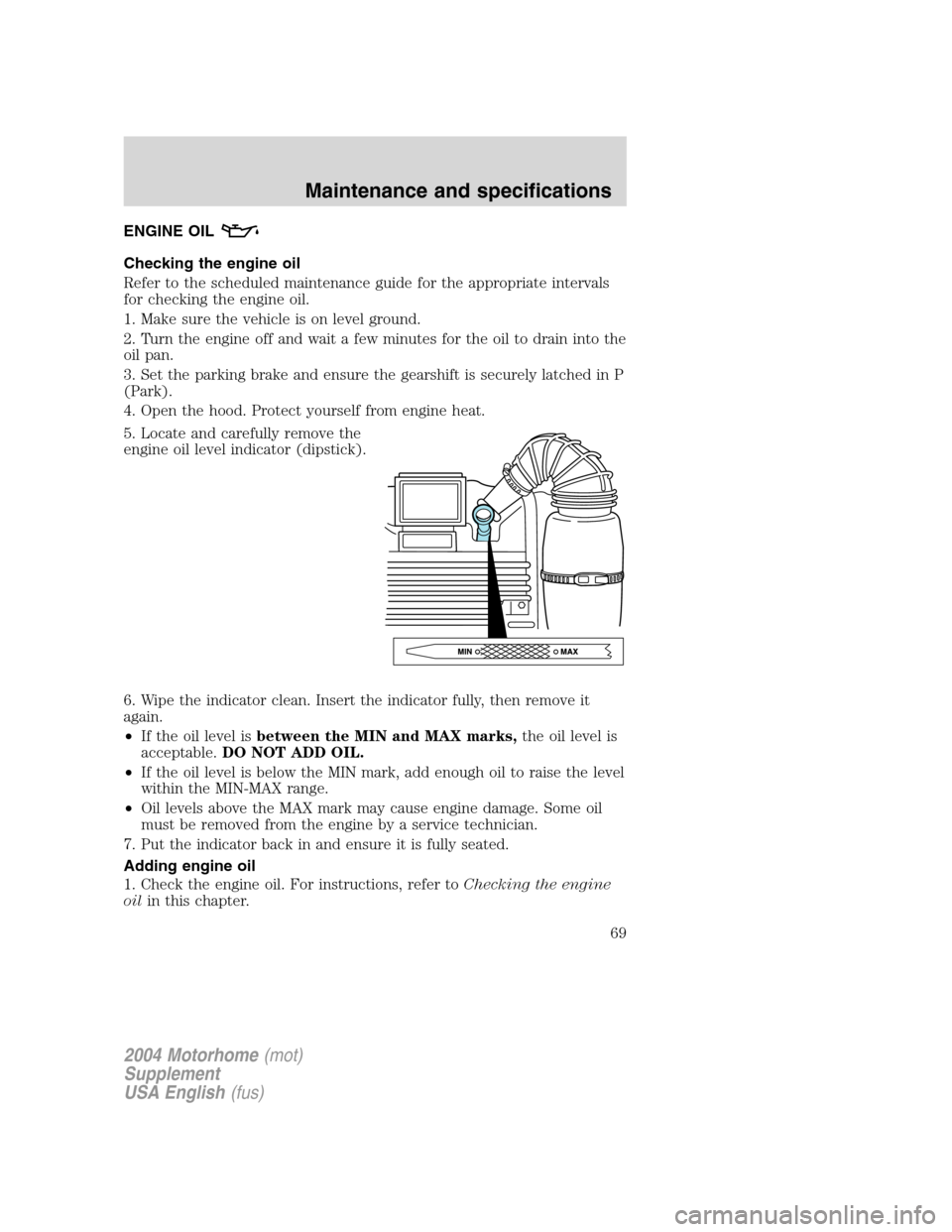
ENGINE OIL
Checking the engine oil
Refer to the scheduled maintenance guide for the appropriate intervals
for checking the engine oil.
1. Make sure the vehicle is on level ground.
2. Turn the engine off and wait a few minutes for the oil to drain into the
oil pan.
3. Set the parking brake and ensure the gearshift is securely latched in P
(Park).
4. Open the hood. Protect yourself from engine heat.
5. Locate and carefully remove the
engine oil level indicator (dipstick).
6. Wipe the indicator clean. Insert the indicator fully, then remove it
again.
•If the oil level isbetween the MIN and MAX marks,the oil level is
acceptable.DO NOT ADD OIL.
•If the oil level is below the MIN mark, add enough oil to raise the level
within the MIN-MAX range.
•Oil levels above the MAX mark may cause engine damage. Some oil
must be removed from the engine by a service technician.
7. Put the indicator back in and ensure it is fully seated.
Adding engine oil
1. Check the engine oil. For instructions, refer toChecking the engine
oilin this chapter.
2004 Motorhome(mot)
Supplement
USA English(fus)
Maintenance and specifications
69
Page 74 of 120
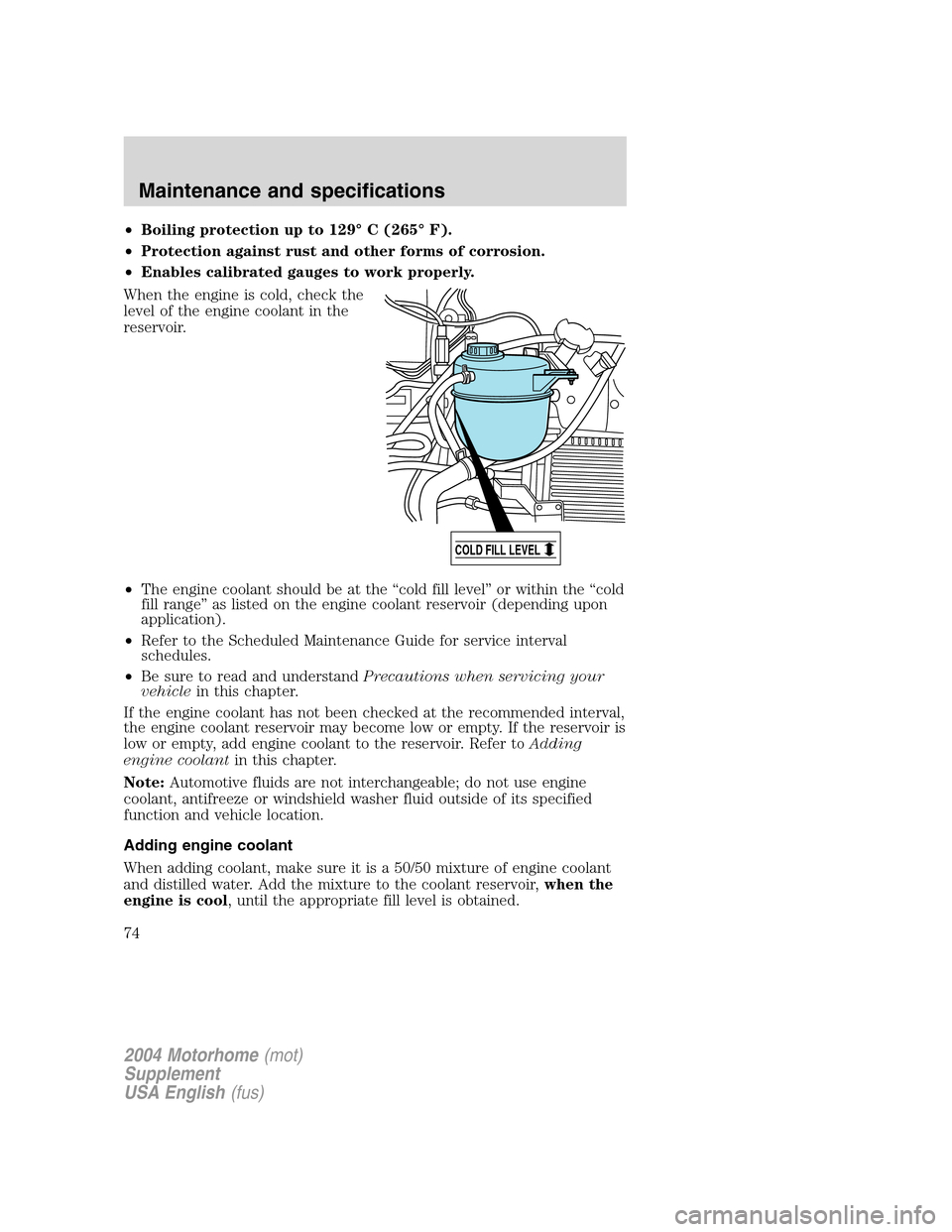
•Boiling protection up to 129°C (265°F).
•Protection against rust and other forms of corrosion.
•Enables calibrated gauges to work properly.
When the engine is cold, check the
level of the engine coolant in the
reservoir.
•The engine coolant should be at the“cold fill level”or within the“cold
fill range”as listed on the engine coolant reservoir (depending upon
application).
•Refer to the Scheduled Maintenance Guide for service interval
schedules.
•Be sure to read and understandPrecautions when servicing your
vehiclein this chapter.
If the engine coolant has not been checked at the recommended interval,
the engine coolant reservoir may become low or empty. If the reservoir is
low or empty, add engine coolant to the reservoir. Refer toAdding
engine coolantin this chapter.
Note:Automotive fluids are not interchangeable; do not use engine
coolant, antifreeze or windshield washer fluid outside of its specified
function and vehicle location.
Adding engine coolant
When adding coolant, make sure it is a 50/50 mixture of engine coolant
and distilled water. Add the mixture to the coolant reservoir,when the
engine is cool, until the appropriate fill level is obtained.
COLD FILL LEVEL
2004 Motorhome(mot)
Supplement
USA English(fus)
Maintenance and specifications
74
Page 87 of 120
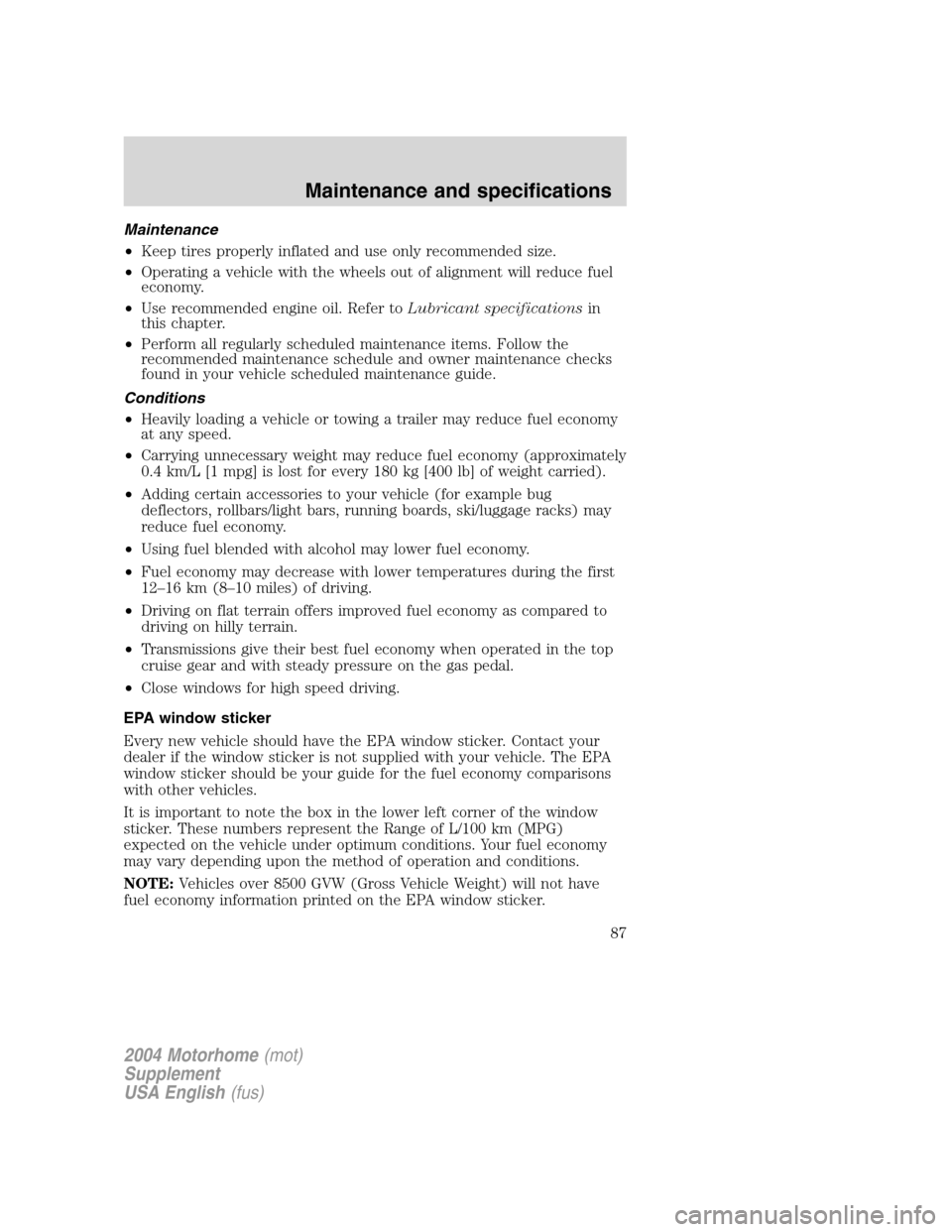
Maintenance
•Keep tires properly inflated and use only recommended size.
•Operating a vehicle with the wheels out of alignment will reduce fuel
economy.
•Use recommended engine oil. Refer toLubricant specificationsin
this chapter.
•Perform all regularly scheduled maintenance items. Follow the
recommended maintenance schedule and owner maintenance checks
found in your vehicle scheduled maintenance guide.
Conditions
•Heavily loading a vehicle or towing a trailer may reduce fuel economy
at any speed.
•Carrying unnecessary weight may reduce fuel economy (approximately
0.4 km/L [1 mpg] is lost for every 180 kg [400 lb] of weight carried).
•Adding certain accessories to your vehicle (for example bug
deflectors, rollbars/light bars, running boards, ski/luggage racks) may
reduce fuel economy.
•Using fuel blended with alcohol may lower fuel economy.
•Fuel economy may decrease with lower temperatures during the first
12–16 km (8–10 miles) of driving.
•Driving on flat terrain offers improved fuel economy as compared to
driving on hilly terrain.
•Transmissions give their best fuel economy when operated in the top
cruise gear and with steady pressure on the gas pedal.
•Close windows for high speed driving.
EPA window sticker
Every new vehicle should have the EPA window sticker. Contact your
dealer if the window sticker is not supplied with your vehicle. The EPA
window sticker should be your guide for the fuel economy comparisons
with other vehicles.
It is important to note the box in the lower left corner of the window
sticker. These numbers represent the Range of L/100 km (MPG)
expected on the vehicle under optimum conditions. Your fuel economy
may vary depending upon the method of operation and conditions.
NOTE:Vehicles over 8500 GVW (Gross Vehicle Weight) will not have
fuel economy information printed on the EPA window sticker.
2004 Motorhome(mot)
Supplement
USA English(fus)
Maintenance and specifications
87
Page 116 of 120
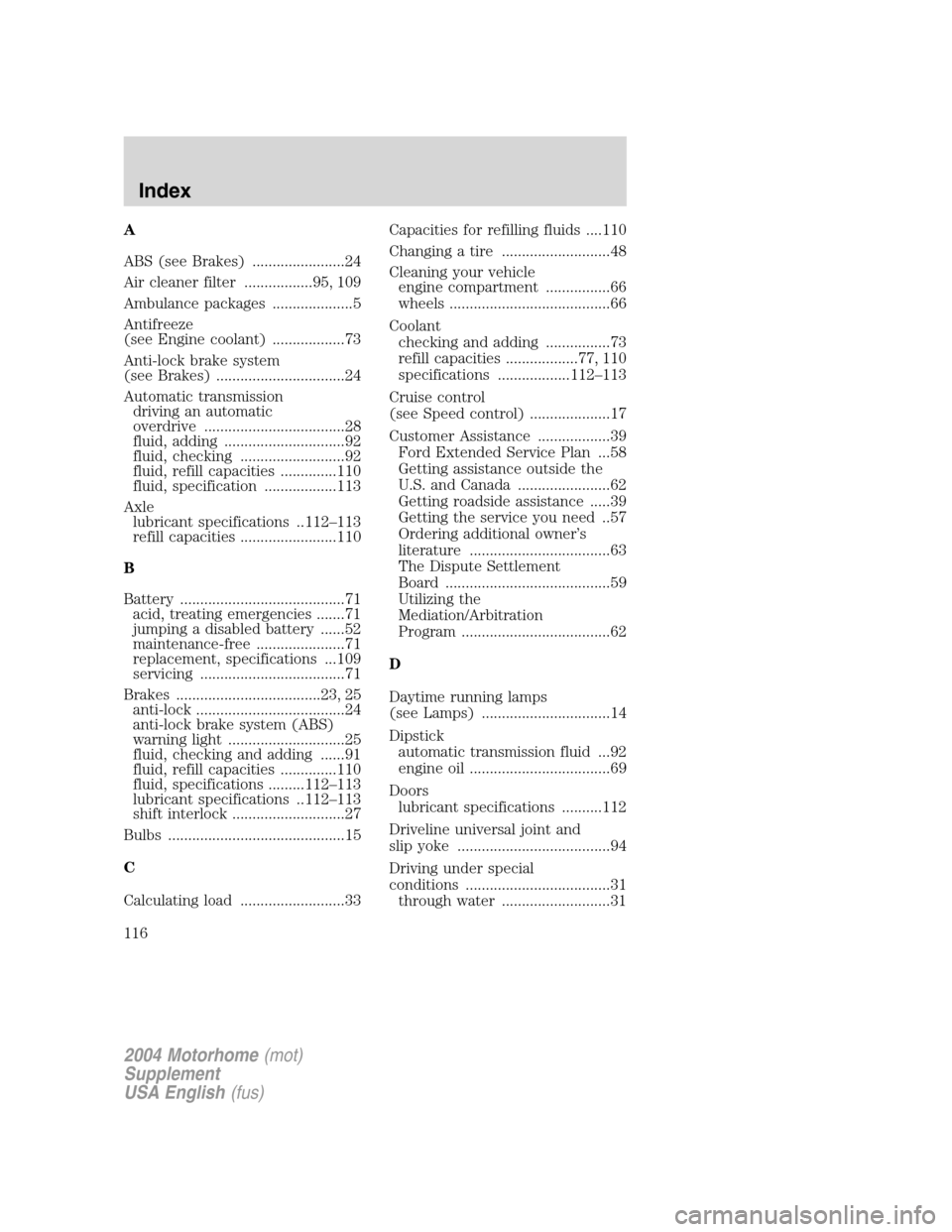
A
ABS (see Brakes) .......................24
Air cleaner filter .................95, 109
Ambulance packages ....................5
Antifreeze
(see Engine coolant) ..................73
Anti-lock brake system
(see Brakes) ................................24
Automatic transmission
driving an automatic
overdrive ...................................28
fluid, adding ..............................92
fluid, checking ..........................92
fluid, refill capacities ..............110
fluid, specification ..................113
Axle
lubricant specifications ..112–113
refill capacities ........................110
B
Battery .........................................71
acid, treating emergencies .......71
jumping a disabled battery ......52
maintenance-free ......................71
replacement, specifications ...109
servicing ....................................71
Brakes ....................................23, 25
anti-lock .....................................24
anti-lock brake system (ABS)
warning light .............................25
fluid, checking and adding ......91
fluid, refill capacities ..............110
fluid, specifications .........112–113
lubricant specifications ..112–113
shift interlock ............................27
Bulbs ............................................15
C
Calculating load ..........................33Capacities for refilling fluids ....110
Changing a tire ...........................48
Cleaning your vehicle
engine compartment ................66
wheels ........................................66
Coolant
checking and adding ................73
refill capacities ..................77, 110
specifications ..................112–113
Cruise control
(see Speed control) ....................17
Customer Assistance ..................39
Ford Extended Service Plan ...58
Getting assistance outside the
U.S. and Canada .......................62
Getting roadside assistance .....39
Getting the service you need ..57
Ordering additional owner’s
literature ...................................63
The Dispute Settlement
Board .........................................59
Utilizing the
Mediation/Arbitration
Program .....................................62
D
Daytime running lamps
(see Lamps) ................................14
Dipstick
automatic transmission fluid ...92
engine oil ...................................69
Doors
lubricant specifications ..........112
Driveline universal joint and
slip yoke ......................................94
Driving under special
conditions ....................................31
through water ...........................31
2004 Motorhome(mot)
Supplement
USA English(fus)
Index
116
Page 117 of 120
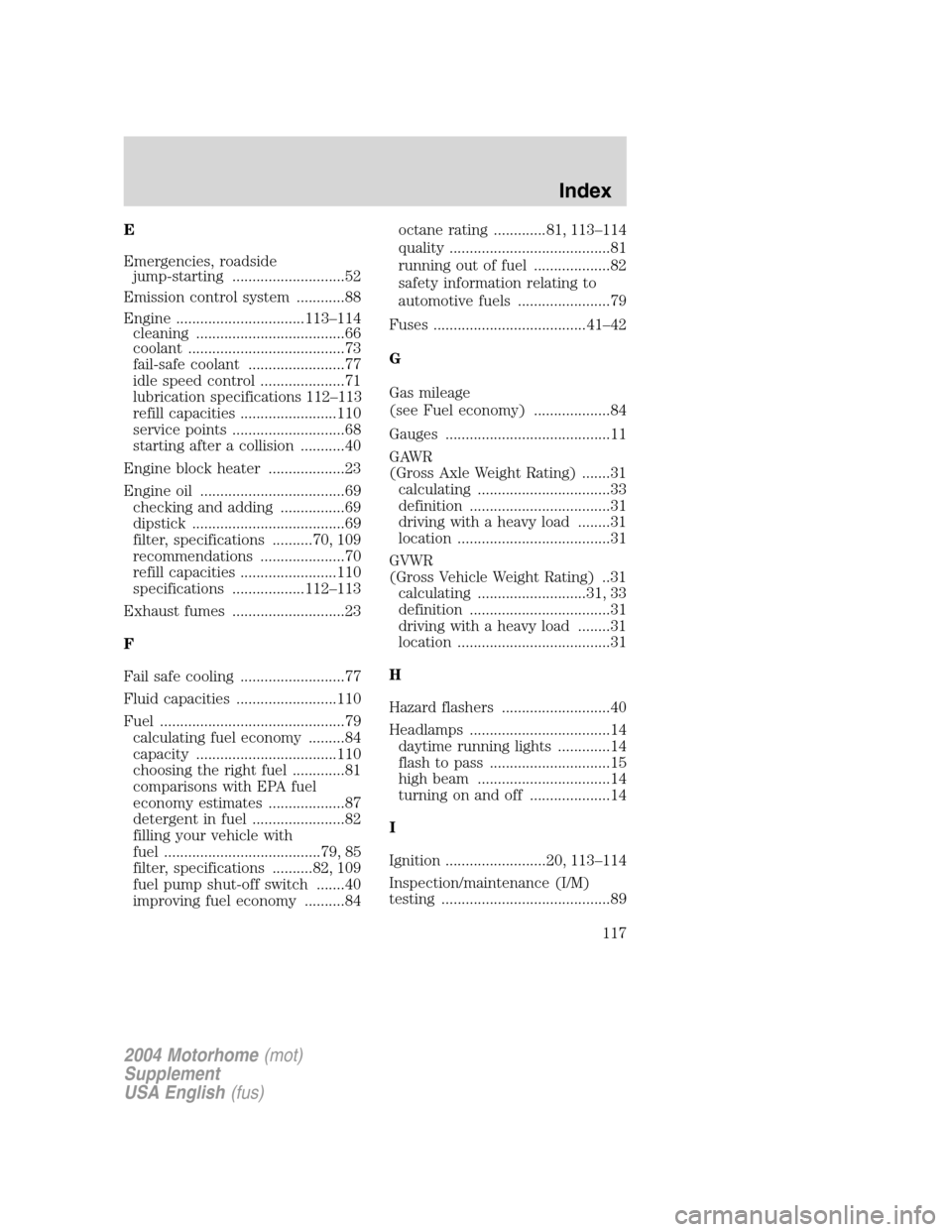
E
Emergencies, roadside
jump-starting ............................52
Emission control system ............88
Engine ................................113–114
cleaning .....................................66
coolant .......................................73
fail-safe coolant ........................77
idle speed control .....................71
lubrication specifications 112–113
refill capacities ........................110
service points ............................68
starting after a collision ...........40
Engine block heater ...................23
Engine oil ....................................69
checking and adding ................69
dipstick ......................................69
filter, specifications ..........70, 109
recommendations .....................70
refill capacities ........................110
specifications ..................112–113
Exhaust fumes ............................23
F
Fail safe cooling ..........................77
Fluid capacities .........................110
Fuel ..............................................79
calculating fuel economy .........84
capacity ...................................110
choosing the right fuel .............81
comparisons with EPA fuel
economy estimates ...................87
detergent in fuel .......................82
filling your vehicle with
fuel .......................................79, 85
filter, specifications ..........82, 109
fuel pump shut-off switch .......40
improving fuel economy ..........84octane rating .............81, 113–114
quality ........................................81
running out of fuel ...................82
safety information relating to
automotive fuels .......................79
Fuses ......................................41–42
G
Gas mileage
(see Fuel economy) ...................84
Gauges .........................................11
GAWR
(Gross Axle Weight Rating) .......31
calculating .................................33
definition ...................................31
driving with a heavy load ........31
location ......................................31
GVWR
(Gross Vehicle Weight Rating) ..31
calculating ...........................31, 33
definition ...................................31
driving with a heavy load ........31
location ......................................31
H
Hazard flashers ...........................40
Headlamps ...................................14
daytime running lights .............14
flash to pass ..............................15
high beam .................................14
turning on and off ....................14
I
Ignition .........................20, 113–114
Inspection/maintenance (I/M)
testing ..........................................89
2004 Motorhome(mot)
Supplement
USA English(fus)
Index
117
Page 118 of 120
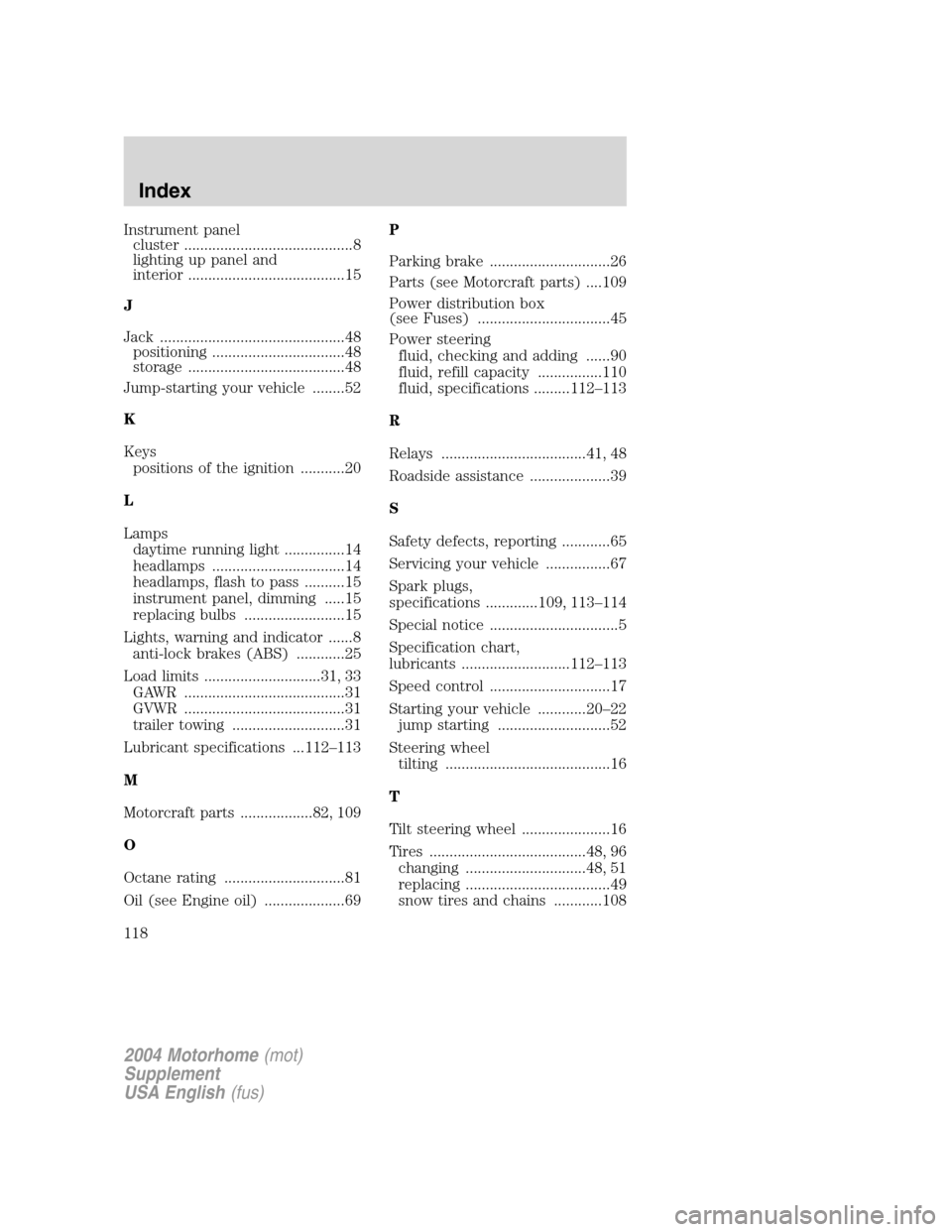
Instrument panel
cluster ..........................................8
lighting up panel and
interior .......................................15
J
Jack ..............................................48
positioning .................................48
storage .......................................48
Jump-starting your vehicle ........52
K
Keys
positions of the ignition ...........20
L
Lamps
daytime running light ...............14
headlamps .................................14
headlamps, flash to pass ..........15
instrument panel, dimming .....15
replacing bulbs .........................15
Lights, warning and indicator ......8
anti-lock brakes (ABS) ............25
Load limits .............................31, 33
GAWR ........................................31
GVWR ........................................31
trailer towing ............................31
Lubricant specifications ...112–113
M
Motorcraft parts ..................82, 109
O
Octane rating ..............................81
Oil (see Engine oil) ....................69P
Parking brake ..............................26
Parts (see Motorcraft parts) ....109
Power distribution box
(see Fuses) .................................45
Power steering
fluid, checking and adding ......90
fluid, refill capacity ................110
fluid, specifications .........112–113
R
Relays ....................................41, 48
Roadside assistance ....................39
S
Safety defects, reporting ............65
Servicing your vehicle ................67
Spark plugs,
specifications .............109, 113–114
Special notice ................................5
Specification chart,
lubricants ...........................112–113
Speed control ..............................17
Starting your vehicle ............20–22
jump starting ............................52
Steering wheel
tilting .........................................16
T
Tilt steering wheel ......................16
Tires .......................................48, 96
changing ..............................48, 51
replacing ....................................49
snow tires and chains ............108
2004 Motorhome(mot)
Supplement
USA English(fus)
Index
118